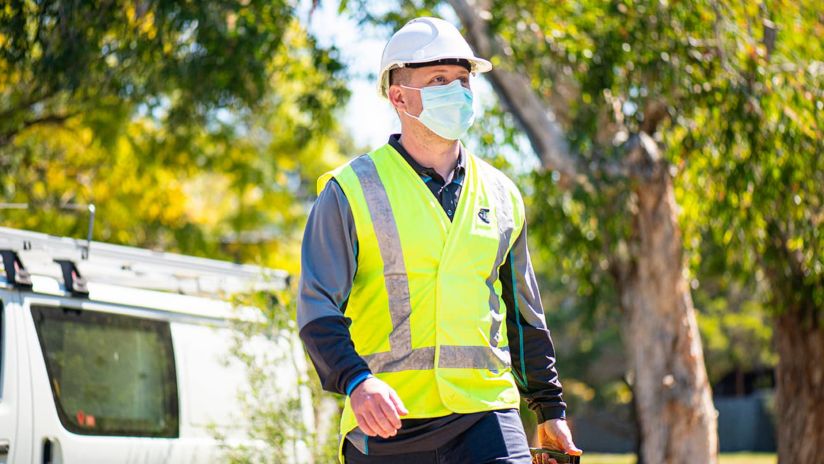FTTP vs FTTN vs FTTC – What’s best for your business?
Want to know how fibre internet could help your business? Learn what FTTP, FTTN and FTTC mean and explore how they could help improve your business operations.

The importance of business internet
Many businesses today depend on the internet to function. The tools you might use to be productive, access data and communicate with customers are ever more connected.
Big data, large files, connected devices, concurrent usage, cloud and collaboration continue to increase and drive internet usage across businesses today.
- Ergo Strategy Business Internet White Paper, Feb 2024
Increased connectivity means your business internet solution is a foundational part of how you do business. In this article we unpack how fibre can offer faster business internet services to a growing number of Australian businesses.
The nbn® fibre upgrade
The choice of your business internet service can impact how smoothly connected services operate. Many businesses connect to the internet is through the nbn's network. You might have heard that selected businesses serviced by the nbn's network via Fibre to the Node (FTTN) and Fibre to the Curb (FTTC) can now upgrade to Fibre to the Premises (FTTP) with an eligible plan.
Internet services that connect through fibre can offer improved broadband speeds, along with higher quality voice and data delivery. But fibre connections are not all the same. It’s important to understand how they differ and what’s available for your business to help boost operations with an nbn tech upgrade.
Comparing technology types
The nbn's network consists of several different technologies. If you’re hoping to upgrade your nbn internet plan, opening new locations or moving premises it’s worth understanding these differences. The technology available at your premises can affect the speed of your internet service.
FTTN
FTTN brings optical fibre to a central point on your street (or nearby street), known as a "node”. From here, it uses existing copper wiring to connect to a wall socket inside your premises.
Network speeds may vary with FTTN connections, depending on how close you are to a node.
FTTB
Fibre to the Building/Basement (FTTB) is the most common connection type for multi-dwelling units. These include units, apartment buildings and many commercial buildings. FTTB connections have an optical fibre into the building’s communications room. The connection to your premises is via existing internal wiring. This wiring is usually copper in older buildings. In newer buildings it usually uses ethernet cables.
FTTC
FTTC is like FTTN and FTTB. There's a fibre optic cable to a small pit or pole outside your premises. The final connection uses the existing copper network.
FTTC can deliver faster potential speeds than FTTN connections. This is because the optical fibre network leads much closer to your connection point. But it's not capable of the same speeds as Fibre to the Premises.
FTTP
FTTP, also called ‘full fibre’, uses optical fibre all the way to your premises. FTTP is typically the highest performing type of nbn connection. This is because fibre can handle higher data speeds and greater reliability. The copper wiring used in other nbn technology types can limit potential speeds.
What are the benefits of Fibre to the Premises?
Fibre to the Premises has important benefits for businesses that rely on internet connectivity.
Faster internet
You can get access to plans with faster internet speeds available on the nbn's network with FTTP.
Many modern business applications are hosted in the cloud. They access data and capabilities from the cloud via the internet. Higher upload and download speeds help these apps perform better. High upload speeds are good for videoconferencing and sending large amounts of data.
Video conferencing, uploading files to the cloud and cloud applications are among the top five business internet use cases, all of which rely on uploading capacity.
- Ergo Strategy Business Internet White Paper, Feb 2024
Lower latency for smoother app performance
Fibre optic networks typically offer lower latency compared to connections using copper wiring. Latency is the round-trip time it takes for data to go from one point to another. Latency is represented in milliseconds (ms). The lower the time, the better.
Low latencies can contribute to better online meeting experiences. Your teams can talk naturally without the connection causing pauses and stutters.
Better reliability and consistency
Unlike traditional copper-based connections, fibre optic cables are less affected by electrical interference and weather conditions. This means you are more likely to get a consistent, smooth experience, with less interruptions.
A future-ready connection
One of the main advantages of full fibre connections is the easy upgrade path. Fibre optic cables have the capacity to handle growing volumes of data for years to come. Once you have fibre to your premises, you can be confident you have a connection that’s ready to grow with your business. The speed and capacity of fibre also helps it support advanced and emerging technologies such as cloud-based data analytics and artificial intelligence (AI) applications.
If you’re interested in AI and how it can benefit your business, read Demystifying Artificial Intelligence for Small Business.
The nbn upgrade program
It’s never been easier to get a full fibre connection on the nbn's network for your business. nbn co limited is rolling out Fibre to the Premises to more locations around Australia. Three million more Australian homes and businesses can now upgrade to full fibre. For selected addresses and with an eligible plan from your internet service provider.
Is nbn's network available in your area?
You can find out if your premises are eligible for upgrade to fibre by using our search tool. Just enter your address in our address checker and you’ll see if FTTP is available in your area.
Once you know what service is available, you can choose the right plan for your business.
If you need more speed or performance
If you need higher internet speeds than are available on nbn's network, you may want to consider business grade fibre. You can choose from a range of high bandwidth options for connectivity that’s tailored to your needs. You can also access equal upload and download speeds for better experiences even at peak times.
Higher speed solutions are useful if you routinely transfer large volumes of data or use multiple high-demand applications simultaneously. For example, medical practices frequently send large data files such as x-rays and medical images between sites. Architects and graphic design agencies are other types of businesses where fast, high-capacity internet helps to ensure their applications work well.
Discover how business grade fibre can boost your productivity
Connectivity to suit the way you work
With the growth of cloud services and video conferencing, your business internet connection has never been more important. Your technology needs to keep pace with your business. If internet connectivity is vital to the way you work, a full fibre connection helps offer you the best of the nbn's network.
FTTP has the speed, bandwidth and reliability to deliver better digital experiences. And it has the scale to cater for your growing demands into the future. The good news is that it’s easier than ever to get fibre to your premises and begin enjoying the benefits. So, make sure to check if FTTP is available in your current location or future business locations you might be considering.
Insights to power your business today and tomorrow
Download your Tech State of Play report to help propel your business further through technology.
Explore more on this topic
Let’s get you growing on business-grade fibre
Connect to business-grade fibre. Now available to more businesses than ever, with 44 new zones in metro and regional areas.




